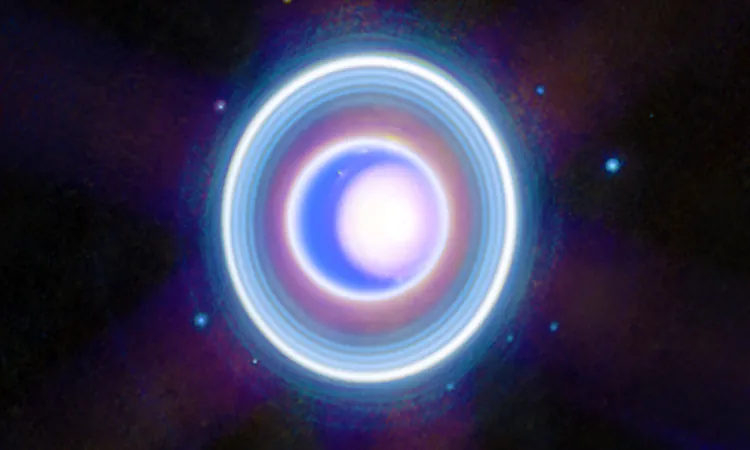
Is There Life Hidden Beneath the Ice? Uranus' Moon Miranda May Harbor an Ocean!
2024-10-31
Author: Nur
A groundbreaking study has unveiled a thrilling possibility: Uranus's moon Miranda, tucked away in the distant corners of our solar system, might possess a concealed ocean beneath its icy shell, potentially offering a cradle for extraterrestrial life.
Unveiling the presence of water on celestial bodies is a formidable challenge, especially when those bodies are located hundreds of millions of miles from Earth. However, Tom Nordheim, a planetary scientist at the Johns Hopkins Applied Physics Laboratory, is at the forefront of this discovery, revealing the potential depths of Miranda in a recent study.
"The prospect of finding an ocean within a small moon like Miranda is tremendously surprising," Nordheim remarked, emphasizing how this discovery reshapes our understanding of Miranda and raises crucial questions about the potential for life beyond our planet.
A Geological Marvel: Miranda’s Strange Surface
When NASA's Voyager 2 spacecraft returned the first detailed images of Miranda in 1986, the world was captivated. The moon boasted a striking landscape, appearing as if it had been compiled from fragments of diverse worlds. Its surface featured deep grooves, soaring cliffs, and intriguing trapezoidal structures known as coronae, leading scientists to ponder the geological mechanisms responsible for such a complex topography.
Understanding Uranus: The Unique Ice Giant
Uranus, often overshadowed by its more famous planetary neighbors, is unique in its axial tilt—rolling on its side and presenting some of the most extreme seasonal variations in the solar system. Each pole experiences 42 years of uninterrupted sunlight followed by an extensive 42 years of darkness, likely the result of a colossal collision early in its history. The planet's atmosphere is rich in icy compounds, including water, ammonia, and methane, the latter lending Uranus its distinctive blue-green hue. With at least 27 moons, some named after Shakespearean characters, and a faint ring system, Uranus is ripe for exploration.
The Enigmatic Hidden Ocean
In a collaborative effort with graduate student Caleb Strom from the University of North Dakota and Alex Patthoff from the Planetary Science Institute, Nordheim approached the study of Miranda with a detective's precision. By re-examining old Voyager 2 imagery and employing modern computational modeling, the team crafted a narrative of Miranda's geological evolution.
Their findings suggest that approximately 100 to 500 million years ago, Miranda might have contained a subsurface ocean estimated to be 62 miles deep, located beneath a frozen crust no thicker than 19 miles. "This revelation astonished our team," Strom noted, highlighting the unexpected findings suggesting that even a minor moon like Miranda could conceal such a significant body of water.
The Heat Beneath: Gravitational Forces at Play
Adding to the mystery, the team's calculations revealed that the ocean could have remained warm enough to sustain its liquid state despite Miranda's remote position from the Sun. This warmth results from gravitational interactions with its neighboring moons, leading to a phenomenon known as orbital resonance, generating friction and internal heat within the moon.
Is the Ocean Still There?
The research is not solely retrospective; the team proposes that Miranda's interior may not have completely frozen. Certain surface features indicative of higher temperatures are still absent, suggesting the possibility of an existing subsurface ocean, albeit likely less extensive than it once was. "The notion that one of the farthest moons in our solar system might harbor an ocean is astonishing," Strom emphasized.
While the idea of extraterrestrial life on moons like Miranda is captivating, researchers acknowledge the need for more data to confirm the existence of the ocean. The analysis of images from the iconic Voyager 2 mission has yielded new insights into Uranus's moons, yet much remains to be explored.
The Future Awaits: Exploring Miranda and Beyond
This isn't the first time a moon has challenged our assumptions. Saturn's Enceladus, discovered in 2004, revealed water vapor geysers indicating a subsurface ocean, now considered a prime candidate for astrobiological exploration. As for Miranda, while it's premature to plan a mission, the tantalizing possibility of life beckons.
To fully unlock the mysteries of this icy moon, researchers advocate for new missions to Uranus, pushing the boundaries of our understanding of these enigmatic worlds. Miranda, previously perceived as a mere frozen remnant, may be the surprising frontier in the quest to find life beyond Earth.
In the vast expanse of our solar system, Miranda stands as an unexpected frontrunner in the hunt for alien life, illuminating the notion that countless discoveries await beneath the surface, urging us to revisit the wonders of our cosmic neighborhood.




 Brasil (PT)
Brasil (PT)
 Canada (EN)
Canada (EN)
 Chile (ES)
Chile (ES)
 Česko (CS)
Česko (CS)
 대한민국 (KO)
대한민국 (KO)
 España (ES)
España (ES)
 France (FR)
France (FR)
 Hong Kong (EN)
Hong Kong (EN)
 Italia (IT)
Italia (IT)
 日本 (JA)
日本 (JA)
 Magyarország (HU)
Magyarország (HU)
 Norge (NO)
Norge (NO)
 Polska (PL)
Polska (PL)
 Schweiz (DE)
Schweiz (DE)
 Singapore (EN)
Singapore (EN)
 Sverige (SV)
Sverige (SV)
 Suomi (FI)
Suomi (FI)
 Türkiye (TR)
Türkiye (TR)
 الإمارات العربية المتحدة (AR)
الإمارات العربية المتحدة (AR)